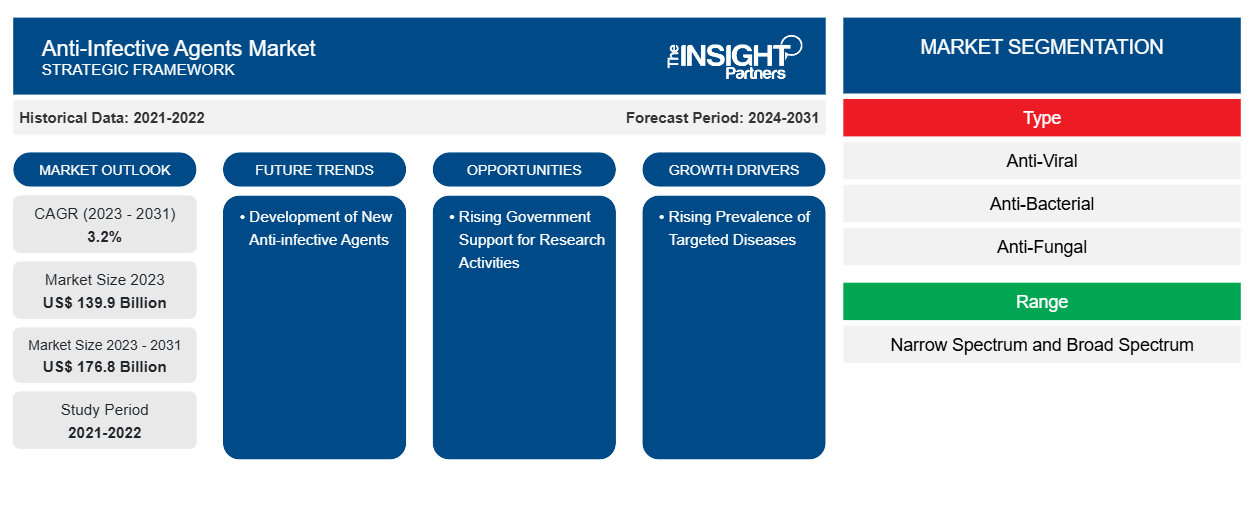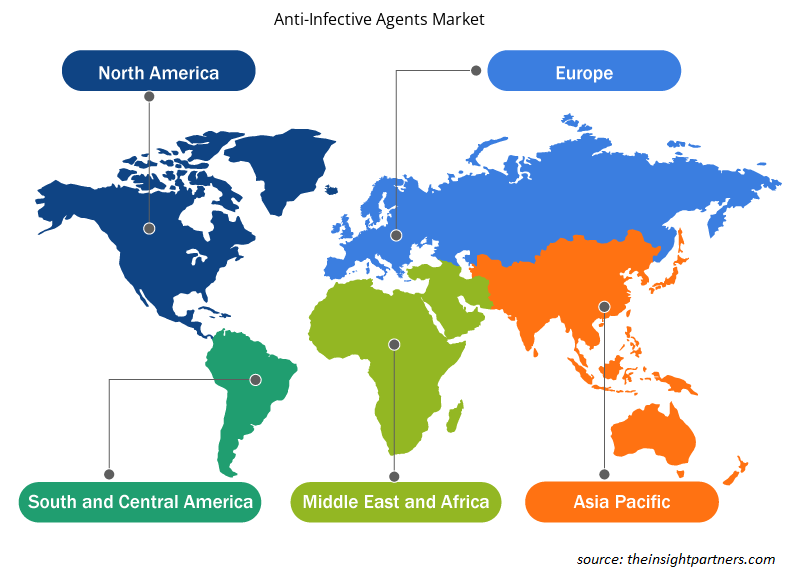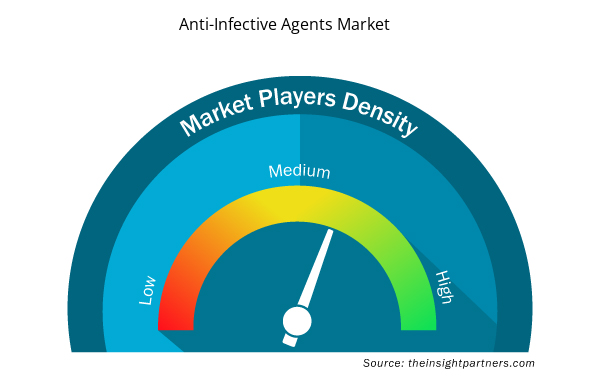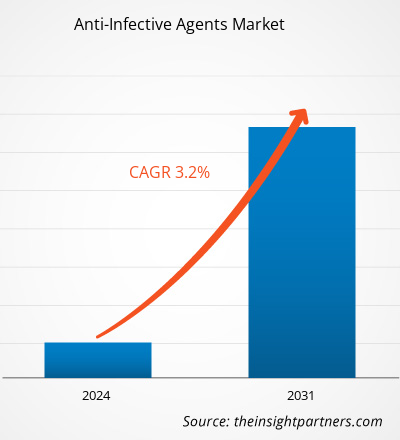The anti-infective agents market size is projected to reach US$ 176.8 billion by 2031 from US$ 139.9 billion in 2023. The market is expected to register a CAGR of 3.2% during 2023–2031. The innovations in drug delivery systems are likely to remain key trends in the market.
Anti-Infective Agents Market Analysis
The rising incidence of infectious diseases drives the market's growth. As per the World Health Organization (WHO), in 2022, 10.6 million people suffered from tuberculosis across the globe, which is an increase from 10.3 million in 2021 and 10.0 million in 2020. Similarly, in 2022, the WHO estimated 249 million malaria cases worldwide. Such high incidence of infectious diseases increases the demand for anti-infective agents market.
Anti-Infective Agents Market Overview
Rising incidence of infectious diseases, increasing occurrence of drugs resistant pathogens, rising aging population, innovations in drug discovery and development, growing support from government initiatives and funding, increasing incidence of hospital acquired infections, robust pipeline of anti-infective drugs and rising public awareness regarding infectious diseases are factors driving the growth of the anti-infective agents market.
Customize This Report To Suit Your Requirement
You will get customization on any report - free of charge - including parts of this report, or country-level analysis, Excel Data pack, as well as avail great offers and discounts for start-ups & universities
Anti-Infective Agents Market: Strategic Insights

- Get Top Key Market Trends of this report.This FREE sample will include data analysis, ranging from market trends to estimates and forecasts.
You will get customization on any report - free of charge - including parts of this report, or country-level analysis, Excel Data pack, as well as avail great offers and discounts for start-ups & universities
Anti-Infective Agents Market: Strategic Insights

- Get Top Key Market Trends of this report.This FREE sample will include data analysis, ranging from market trends to estimates and forecasts.
Anti-Infective Agents Market Drivers and Opportunities
Increasing Occurrence of Drugs Resistant Pathogens to Favor Market
Increasing antibiotic resistance pathogens increases the demand for new anti-infective agents. As per the Centers for Disease Control and Prevention, in the U.S., over 2.8 million antimicrobial-resistant infections occur every year. Similarly, as per the latest national surveillance data, UK Health Security Agency (UKHSA) annual conference, estimated that 58,224 people in England had an antibiotic resistant infection in 2022, that is a rise of 4% since 2021 (55,792).
Government Support and Initiatives likely to Create Growth Opportunities
Support from government organizations to develop new anti-infective drugs and distribute anti-infective agents is likely to favor the growth of the market. For instance, the Government of India, through the National AIDS and STD Control Programme (NACP), will provide high-quality anti-retroviral (ARV) medicines free of cost to people suffering from HIV from treatment facilities across the country.
Similarly, to end the HIV epidemic, the US Government invests billions to support HIV testing, prevention, treatment, and research initiatives across the country and the globe. The US government spends over US$ 28 billion per year to support the implementation of the Ending the HIV Epidemic in the US (EHE).
Anti-Infective Agents Market Report Segmentation Analysis
Key segments that contributed to the derivation of the anti-infective agents Market analysis are type, range, animal type, disease type, and end user.
- The anti-infective agents market, by type, is segmented into anti-bacterial, anti-viral, anti-fungal, and others. The anti-viral segment held the largest share of the market in 2022. The anti-viral segment is anticipated to register the highest CAGR in the market during the forecast period.
- Based on range, the global anti-infectives agents market is segmented into broad-spectrum, and narrow spectrum. In 2023, the narrow spectrum segment held the largest share of the market. However, the broad-spectrum segment is expected to witness growth in its demand at a fastest CAGR during the forecast period.
- By route of administration, the market is segmented into topical, oral, IV, and others. In 2023, the IV segment held the largest share of the market. However, the topical segment is expected to witness growth in its demand at a fastest CAGR during the forecast period.
- In terms of indication, the global anti-infectives agents market is segmented into HIV, tuberculosis, respiratory infection, pneumonia, and others. In 2022, the HIV segment is likely to hold the largest share of the market. Moreover, the same segment is expected to witness growth in its demand at a fastest CAGR during the forecast period.
- Based on distribution channel, the global anti-infectives agents market is segmented into hospital pharmacies, specialty pharmacies, e-commerce, and others. In 2022, the hospital pharmacies segment is likely to hold the largest share of the market. However, the e-commerce segment is anticipated to register the highest CAGR in the market during the forecast period.
Anti-Infective Agents Market Share Analysis by Geography
The geographic scope of the Anti-Infective Agents Market report is mainly divided into five regions: North America, Asia Pacific, Europe, Middle East & Africa, and South & Central America.
The North America anti-infective agents market has been segmented into the US, Canada, and Mexico. The increasing number of product approvals with growing research & development activities, and rising demand for advanced therapeutic solutions to treat chronic conditions and viral diseases are among the prominent factors propelling the market growth in this region.
Europe is the second-largest market owing to factors such as the rising geriatric population, increasing prevalence of chronic viral diseases, and high demand for developing new anti-viral drugs in the region. With USD 15.79 billion funded from 2007 to 2019 through the 7th Framework Program and Horizon 2020, in addition to the USD 1.1 billion pledged for coronavirus research, the EU plays a crucial role in funding and coordinating research on infectious diseases.
Anti-Infective Agents Market Regional Insights
The regional trends and factors influencing the Anti-Infective Agents Market throughout the forecast period have been thoroughly explained by the analysts at Insight Partners. This section also discusses Anti-Infective Agents Market segments and geography across North America, Europe, Asia Pacific, Middle East and Africa, and South and Central America.

- Get the Regional Specific Data for Anti-Infective Agents Market
Anti-Infective Agents Market Report Scope
| Report Attribute | Details |
|---|---|
| Market size in 2023 | US$ 139.9 Billion |
| Market Size by 2031 | US$ 176.8 Billion |
| Global CAGR (2023 - 2031) | 3.2% |
| Historical Data | 2021-2022 |
| Forecast period | 2024-2031 |
| Segments Covered |
By Type
|
| Regions and Countries Covered | North America
|
| Market leaders and key company profiles |
Anti-Infective Agents Market Players Density: Understanding Its Impact on Business Dynamics
The Anti-Infective Agents Market is growing rapidly, driven by increasing end-user demand due to factors such as evolving consumer preferences, technological advancements, and greater awareness of the product's benefits. As demand rises, businesses are expanding their offerings, innovating to meet consumer needs, and capitalizing on emerging trends, which further fuels market growth.
Market players density refers to the distribution of firms or companies operating within a particular market or industry. It indicates how many competitors (market players) are present in a given market space relative to its size or total market value.
Major Companies operating in the Anti-Infective Agents Market are:
- Abbott
- Allergan Plc.
- Astellas Pharma Inc.
- Merck & Co., Inc.
- Bayer AG
- Bristol-Myers Squibb Company
Disclaimer: The companies listed above are not ranked in any particular order.

- Get the Anti-Infective Agents Market top key players overview
Anti-Infective Agents Market News and Recent Developments
The anti-infective agents market is evaluated by gathering qualitative and quantitative data post primary and secondary research, which includes important corporate publications, association data, and databases. A few of the developments in the Anti-Infective Agents Market are listed below:
- Sandoz, a Novartis Division, announced its extension of collaboration agreement with Ares Genetics (Ares), aimed at driving cutting-edge digital solutions in the global fight against antimicrobial resistance (AMR). (Source: Sandoz, Press Release/Company Website/Newsletter, April 2022)
- Orchid Pharma has partnered with Cipla to distribute its breakthrough antibiotic combination across India. (Source: Cipla, Press Release/Company Website/Newsletter, July 2024)
Anti-Infective Agents Market Report Coverage and Deliverables
The “Anti-Infective Agents Market Size and Forecast (2021–2031)” report provides a detailed analysis of the market covering below areas:
- Anti-Infective Agents Market size and forecast at global, regional, and country levels for all the key market segments covered under the scope
- Anti-Infective Agents Market trends as well as market dynamics such as drivers, restraints, and key opportunities
- Detailed PEST/Porter’s Five Forces and SWOT analysis
- Anti-Infective Agents Market analysis covering key market trends, global and regional framework, major players, regulations, and recent market developments
- Industry landscape and competition analysis covering market concentration, heat map analysis, prominent players, and recent developments for the Anti-Infective Agents Market
- Detailed company profiles
- Historical Analysis (2 Years), Base Year, Forecast (7 Years) with CAGR
- PEST and SWOT Analysis
- Market Size Value / Volume - Global, Regional, Country
- Industry and Competitive Landscape
- Excel Dataset



Report Coverage
Revenue forecast, Company Analysis, Industry landscape, Growth factors, and Trends

Segment Covered
Type, Range, Route of Administration, Indication, and Distribution Channel

Regional Scope
North America, Europe, Asia Pacific, Middle East & Africa, South & Central America

Country Scope
Argentina, Australia, Brazil, Canada, China, France, Germany, India, Italy, Japan, Mexico, RoAPAC, RoE, RoMEA, RoSCAM, Saudi Arabia, South Africa, South Korea, Spain, United Arab Emirates, United Kingdom, United States
Frequently Asked Questions
What is the expected CAGR of the anti-infective agents market?
The anti-infective agents market is estimated to grow with a CAGR of 3.2% from 2023 to 2031.
What would be the estimated value of the anti-infective agents market by 2031?
The estimated value of the anti-infective agents market by 2031 is US$ 176.8 billion billion
Which are the leading players operating in the anti-infective agents market?
The anti-infectives agents market majorly consists of the players such as Abbott, Allergan Plc., Astellas Pharma Inc., Merck & Co., Inc., Bayer AG, Bristol-Myers Squibb Company, Boehringer Ingelheim International GmbH, F. HOFFMANN-LA ROCHE Ltd., Gilead Sciences, Inc., GlaxoSmithKline plc., Novartis AG among others.
What are the future trends of the anti-infective agents market Market?
Rising Investments in R&D Activities in Pharmaceutical Sector
What are the driving factors impacting the anti-infective agents market Market?
The market drivers include rising prevalence of targeted diseases and rising government support for research activities and clinical trials are leading to increasing usage of anti-infectives agents market. However, emergence of anti-infective drugs resistance and their side effects is a key restraining factor for the market growth.
Which region dominated the anti-infective agents market Market in 2023?
North America dominated the anti-infective agents market in 2023

 Get Free Sample For
Get Free Sample For